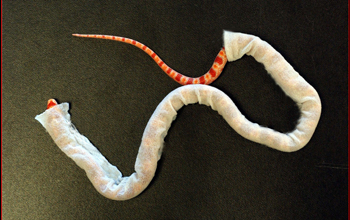Multimedia Gallery
Corn snake wearing cloth jacket for experiment on serpentine movement
This corn snake is wearing a cloth jacket for an experiment that showed how snake scales help serpentine movement on flat surfaces.
More about this image
"Snake scales are smooth in order to decrease their friction going forward, but the way they're overlapping on the belly makes them actually quite rough if you rub them in the opposite direction," says David Hu, a mechanical engineer at Georgia Tech. And it's this roughness that's the secret to how scales propel snakes forward. "They [scales] catch in the ground when the snakes pushing to the side or when it's being slid backwards and they have a preferential direction of sliding forwards," adds Hu.
This fundamental design of the snake scale is shared by other things in our daily lives -- like wheels and ice skates. When comparing snake scales to ice skates, Hu says "they can go easily forward but as you know, when you're ice skating you can push sideways and they'll catch, so we found the snake scales are a lot like wheels and ice skates in that they slide much easier in one direction than in another."
Previous research had assumed that snakes move by pushing off of the rocks and debris around them, but that didn't explain how they can move in areas where there isn't anything to push on. The necessity of snake scales to locomotion can be shown by putting snakes on smooth surfaces or enveloping their scales in cloth. In both of these cases, snakes are unable to slither forward. This is because their scales cannot gain traction on the ground. For their research, Hu and his team designed a special jacket that keeps the snake's scales from gripping the ground. "If you put this jacket on the snake, there's high friction on the ground but the friction is equal in all directions so the snake can't move," says Hu.
Hu's research was supported by a grant from the National Science Foundation (grant PHY 0848894). To learn more about this research, see the LiveScience article Study shows how snakes slither. (Date of Image: 2009)
Credit: ©Grace Pryor, Mike Shelley and David Hu, Applied Mathematics Laboratory, New York University, and Department of Mechanical Engineering, Georgia Institute of Technology
See other images like this on your iPhone or iPad download NSF Science Zone on the Apple App Store.
Images and other media in the National Science Foundation Multimedia Gallery are available for use in print and electronic material by NSF employees, members of the media, university staff, teachers and the general public. All media in the gallery are intended for personal, educational and nonprofit/non-commercial use only.
Images credited to the National Science Foundation, a federal agency, are in the public domain. The images were created by employees of the United States Government as part of their official duties or prepared by contractors as "works for hire" for NSF. You may freely use NSF-credited images and, at your discretion, credit NSF with a "Courtesy: National Science Foundation" notation.
Additional information about general usage can be found in Conditions.
Also Available:
Download the high-resolution TIF version of the image. (22.5 MB)
Use your mouse to right-click (Mac users may need to Ctrl-click) the link above and choose the option that will save the file or target to your computer.

 All images in this series
All images in this series